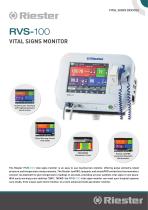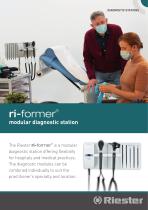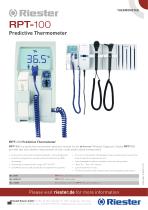
Trolley-mounted patient monitor RVS-100modularSpO2NIBP
Add to favorites
Compare this product
fo_shop_gate_exact_title
Characteristics
- Configuration
- modular, trolley-mounted
- Measured parameter
- TEMP, pulse rate, NIBP, SpO2
- Applications
- clinical, physiological
- Options and accessories
- wireless
- Other characteristics
- continuous
- Screen size
8 in
- Battery life
17 h
- Weight
3,600 g
(127 oz)- Pulse rate
Max.: 250 unit
Min.: 20 unit
- Oxygen level
Max.: 100 %
Min.: 0 %
Description
The flexible, modular design offers many configurations and settings to suit the needs of hospitals and clinics as well as office based and long-term care settings.
The device has ‘Monitor‘, ‘Spot Check‘ and ‘Triage‘ profile options, as well as a ‘Demo’ mode.
Continuous Monitoring is designed for monitoring patients over time and includes physiological and technical alarms. Spot Check is designed for taking a single set of vital signs measurements on a patient. Patient information can be entered and managed, and while technical alarms are still available, physiological alarms are disabled. Triage is designed for rapidly taking vital signs measurements on many patients. Patient information is disabled, in addition to physiological alarms. ‘Demo’ mode demonstrates how each measurement mode works.
Advantages
The aim of the EWS is to improve patient outcomes by identifying at risk patients who need urgent medical attention and intervening early to prevent clinical deterioration. This system involves the assignment of numeric values to several physiologic parameters. RVS-100 can be programmed with NEWS (National Early Warning Scores), MEWS (Modified Early Warning Scores) and also has 5 customisable profiles which can be set by the end-user if they have different parameter values.
Improved efficiency
RVS-100 can communicate through a wired or wireless connection to the hospital's EMR/EHR, according to the HL7 standard, reducing the time spent and the likelihood of recording errors.
Designed for your patients' needs
RVS-100 is a versatile, modular system meaning that you can select the options to fulfil your patient monitoring needs.
Catalogs
Related Searches
- Patient monitor
- SpO2 monitor
- Hospital pulse oximeter
- Blood pressure patient monitor
- Fingertip pulse oximeter
- Pulse oximetry patient monitor
- NIBP patient monitor
- Temperature patient monitor
- Battery-powered pulse oximeter
- Clinical patient monitor
- Pulse rate patient monitor
- Wireless pulse oximeter
- Continuous patient monitor
- OLED pulse oximeter
- Home care pulse oximeter
- Blue pulse oximeter
- Modular patient monitor
- Trolley-mounted patient monitor
- Physiological patient monitor
- Diagnostic station
*Prices are pre-tax. They exclude delivery charges and customs duties and do not include additional charges for installation or activation options. Prices are indicative only and may vary by country, with changes to the cost of raw materials and exchange rates.





